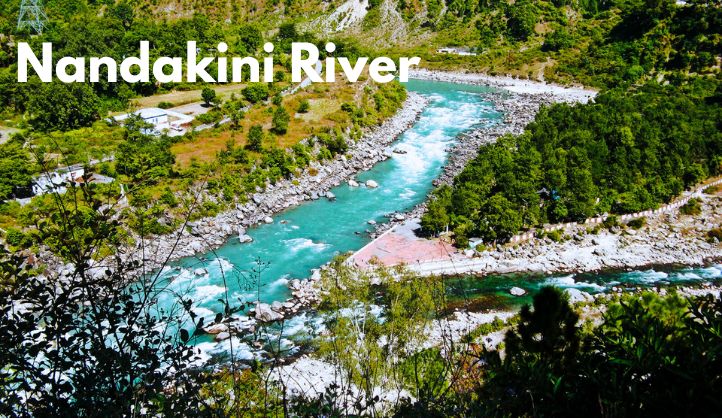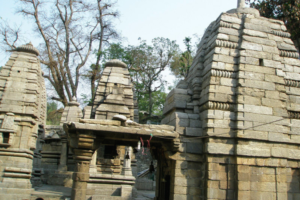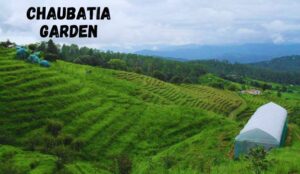Uttarakhand, known as the “Land of the Gods,” is home to some of the most beautiful rivers in India. Among these rivers, the Nandakini River stands out as a lesser-known yet enchanting gem. Originating from the Chamoli district, the Nandakini River weaves a tale of natural beauty, spiritual significance, and adventure. Join us as we embark on a journey to explore the wonders of the Nandakini River.
The Birth of the Nandakini River
Where It All Begins
The Nandakini River originates from the Nanda Ghunti peak in the Garhwal Himalayas. This majestic peak, standing tall at over 6,000 meters, gives birth to the river through the melting glaciers. As the Nandakini River cascades down the mountain slopes, it gathers momentum, carving a path through the picturesque valleys and dense forests of Chamoli district.
A Journey Through Chamoli
Flowing for approximately 40 kilometers, the Nandakini River meanders through Chamoli, creating a breathtaking landscape. The river’s journey is marked by serene meadows, lush forests, and quaint villages. Each bend in the river offers a new perspective on the natural beauty that defines this region.
Spiritual Significance
A Sacred River
In Uttarakhand, rivers are often considered sacred, and the Nandakini River is no exception. Named after the revered goddess Nanda Devi, the river holds a special place in the hearts of the locals and pilgrims. The Nandakini River’s spiritual journey culminates at Nandprayag, where it merges with the Alaknanda River. This confluence is one of the Panch Prayag, the five sacred river confluences in the Garhwal region.
The Pilgrimage Site of Nandprayag
Nandprayag, where the Nandakini meets the Alaknanda, is a revered pilgrimage site. Devotees believe that taking a dip in the waters at this confluence can cleanse one’s sins and bring spiritual rejuvenation. The peaceful ambiance of Nandprayag, combined with the gentle flow of the rivers, creates a tranquil setting for reflection and prayer.
Natural Splendor
A Tapestry of Green
The Nandakini River flows through some of the most verdant landscapes in Uttarakhand. The riverbanks are adorned with a rich tapestry of green, featuring dense forests, terraced fields, and vibrant wildflowers. The natural beauty of the Nandakini River valley is a feast for the eyes and a haven for nature lovers.
Flora and Fauna
The region surrounding the Nandakini River is part of the Nanda Devi Biosphere Reserve, a UNESCO World Heritage Site. This reserve is renowned for its biodiversity, housing rare and endangered species. Wildlife enthusiasts might spot the elusive snow leopard, Himalayan tahr, and a variety of bird species. The river’s ecosystem supports a diverse range of flora and fauna, making it a vital part of the region’s natural heritage.
Adventure Awaits
White-Water Thrills
For those seeking adventure, the Nandakini River offers thrilling opportunities for white-water rafting and kayaking. The river’s varying flow, with its gentle stretches and occasional rapids, makes it an exciting destination for water sports. Adventure seekers can navigate the river’s twists and turns, experiencing the rush of the rapids while surrounded by stunning scenery.
Trekking and Camping
The trails along the Nandakini River are perfect for trekking and camping. Hikers can explore the scenic routes that wind through the valleys and forests, offering panoramic views of the Himalayan peaks. Camping by the riverbank, under a star-studded sky, provides a serene and unforgettable experience. The sound of the flowing river adds a soothing backdrop to the adventure.
Cultural Heritage
Traditional Villages
The villages along the Nandakini River offer a glimpse into the rich cultural heritage of Uttarakhand. The local communities, primarily comprising Garhwali people, have preserved their traditional lifestyle and customs. Visitors can experience the warm hospitality of the locals, participate in cultural festivals, and savor the delicious local cuisine. Traditional dance and music performances provide insights into the region’s folklore and traditions.
Local Handicrafts
Chamoli district is known for its exquisite handicrafts, including handwoven textiles, wood carvings, and intricate jewelry. Visitors can explore local markets and workshops to discover these beautiful crafts. Purchasing these handmade items not only supports local artisans but also provides a unique memento of the visit.
Sustainable Tourism
Preserving Natural Beauty
As the Nandakini River gains popularity as a tourist destination, there is an increasing emphasis on sustainable tourism practices. Efforts are being made to promote eco-friendly activities, reduce the environmental impact of tourism, and involve local communities in conservation initiatives. Travelers are encouraged to respect the natural surroundings, avoid littering, and support local businesses to ensure the long-term preservation of this pristine river and its surroundings.
Community Involvement
Sustainable tourism in the Nandakini River region involves the local communities in various conservation and tourism activities. Community-based tourism initiatives help to provide economic opportunities for locals while preserving the cultural and natural heritage of the area. Visitors can participate in these initiatives, gaining a deeper understanding of the region and its people.
Other rivers in Uttarakhand
Uttarakhand, a state known for its stunning landscapes and spiritual significance, is blessed with numerous rivers. Each river has its unique origin, journey, and importance. Here’s a look at some of the other prominent rivers in Uttarakhand:
Prominent Rivers of Uttarakhand
1. Ganga River
Origin: Gangotri Glacier, Uttarkashi district
Course: Flows through the state of Uttarakhand, merging with the Yamuna in the plains of northern India. It travels through the states of Uttar Pradesh, Bihar, Jharkhand, and West Bengal before emptying into the Bay of Bengal.
The Ganga, or Ganges, is considered the holiest river in Hinduism. It is worshipped as the goddess Ganga and plays a crucial role in Indian culture and spirituality. Major cities along its route, such as Haridwar and Rishikesh, are significant pilgrimage sites.
2. Yamuna River
Origin: Yamunotri Glacier, Uttarkashi district
Course: Flows through Uttarakhand and then moves through the states of Haryana, Delhi, and Uttar Pradesh before merging with the Ganga at Prayagraj.
The Yamuna River is also considered sacred and is associated with the goddess Yamuna. It is an important river in Hindu mythology and culture. The river is closely linked with the stories of Lord Krishna, who is said to have played in its waters.
3. Alaknanda River
Origin: Satopanth Glacier near Badrinath
Course: Flows through the Chamoli district, merging with the Bhagirathi River at Devprayag to form the Ganga.
The Alaknanda is one of the two main headstreams of the Ganga. It is known for its fast-flowing waters and is a crucial river in the spiritual and cultural landscape of Uttarakhand.
4. Bhagirathi River
Origin: Gangotri Glacier
Course: Flows through the Uttarkashi district before joining the Alaknanda at Devprayag.
The Bhagirathi River is revered as the source stream of the Ganga. It is named after King Bhagirath, who is said to have brought the Ganga to the earth through his penance.
5. Mandakini River
Origin: Chorabari Glacier near Kedarnath
Course: Flows through Rudraprayag district and merges with the Alaknanda at Rudraprayag.
The Mandakini River is significant for its association with the Kedarnath Temple. The river’s pristine waters and scenic beauty make it a popular spot for pilgrims and tourists alike.
6. Kali River
Origin: Greater Himalayas at Kalapani
Course: Flows through the Kumaon region and forms part of the border between India and Nepal.
The Kali River, also known as the Sharda River, is important for its role in defining the international boundary between India and Nepal. It also has cultural significance in the Kumaon region.
7. Saryu River
Origin: Sarmul peak, Kumaon Himalayas
Course: Flows through Bageshwar and merges with the Kali River at Pancheshwar.
The Saryu River holds cultural importance in the Kumaon region and is mentioned in various Hindu texts. It provides irrigation and supports agriculture in the region.
8. Ramganga River
Origin: Namik Glacier (eastern Ramganga) and Garhwal Himalayas (western Ramganga)
Course: Flows through Jim Corbett National Park and merges with the Ganga in the plains.
The Ramganga River is vital for its ecological significance, flowing through Jim Corbett National Park, which is home to a diverse range of wildlife. The river supports the park’s ecosystem and is crucial for conservation efforts.
9. Tons River
Origin: Bandarpunch mountain range
Course: Flows through the Tons Valley and joins the Yamuna River.
The Tons River is known for its challenging rapids and is a popular destination for white-water rafting. It also adds to the scenic beauty of the Tons Valley.
10. Pindar River
- Origin: Pindari Glacier
- Course: Flows through the Kumaon Himalayas and joins the Alaknanda at Karnaprayag.
The Pindar River is known for its stunning natural beauty and the Pindari Glacier trek. It plays a crucial role in the hydrology and ecology of the Kumaon region.
Conclusion
The Nandakini River, with its serene beauty, spiritual significance, and adventurous spirit, is truly an untouched gem of Uttarakhand. Whether you are a pilgrim seeking spiritual solace, an adventurer looking for a thrill, or a nature lover yearning for tranquility, the Nandakini River has something to offer. As you explore this enchanting river and its surroundings, you’ll not only create unforgettable memories but also develop a deep appreciation for the natural and cultural heritage of Uttarakhand.
Plan your visit to the Nandakini River and immerse yourself in the timeless beauty and serenity of this hidden treasure in the Himalayas. Respect the environment, embrace the local culture, and contribute to the sustainable preservation of this magnificent river. Let the Nandakini River inspire your journey and leave you with memories that will last a lifetime.
FAQs About Nandakini River
1. Where does the Nandakini River originate?
- The Nandakini River originates from the Nanda Ghunti peak in the Garhwal Himalayas, located in the Chamoli district of Uttarakhand.
2. What is the significance of the name ‘Nandakini’?
- The river is named after the goddess Nanda Devi, who is highly revered in the region. The name ‘Nandakini’ signifies the river’s connection to this goddess.
3. How long is the Nandakini River?
- The Nandakini River flows for approximately 40 kilometers through the Chamoli district before merging with the Alaknanda River at Nandprayag.
4. What is the spiritual importance of the Nandakini River?
- The Nandakini River holds significant spiritual value, especially at Nandprayag, where it meets the Alaknanda River. This confluence is one of the Panch Prayag, considered sacred in Hinduism.
5. Can one go rafting or kayaking on the Nandakini River?
- While the Nandakini River is known for its scenic beauty, it is not typically a major destination for rafting or kayaking compared to rivers like the Ganga or Alaknanda. However, its serene and less turbulent waters can be suitable for some recreational water activities.





